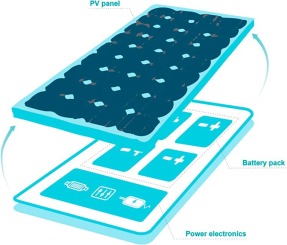Applied Energy ( IF 11.2 ) Pub Date : 2017-10-21 , DOI: 10.1016/j.apenergy.2017.10.007 Victor Vega-Garita , Laura Ramirez-Elizondo , Pavol Bauer

|
Solar-battery systems are still expensive, bulky, and space consuming. To tackle these issues, we propose a novel device that combines all the components of a solar-battery system in one device. This device might help reduce installation cost compared to the current solar-battery systems as well as provide a plug-and-play solution. However, this physical integration means higher temperatures for the components. Therefore, this paper presents a thermal analysis of the physical integration concept to evaluate its feasibility, focusing on the batteries, the most delicate components. The thermal analysis was conducted using a Finite Element Method model and validated with experimental results on a prototype. According to the model, the temperature of the components (battery and converters) reduced drastically by adding an air gap of 5–7 cm between the solar panel and the components. Even under severe conditions, maximum battery temperature never surpassed the highest temperature of operation defined by the manufacturer. Moreover, the maximum battery temperature decreases even further by applying a phase change material as a passive cooling method, reducing it by 5 °C. As a result, the battery pack operates in a safe range when combined with a 265 Wp solar panel, demonstrating the potential of this concept for future solar-battery applications.
中文翻译:

光伏电池系统的物理集成:热分析
太阳能电池系统仍然昂贵,笨重且占用空间。为了解决这些问题,我们提出了一种新颖的设备,它将太阳能电池系统的所有组件组合到一个设备中。与当前的太阳能电池系统相比,该设备可能有助于降低安装成本,并提供即插即用功能解决方案。但是,这种物理集成意味着部件的温度更高。因此,本文对物理集成概念进行了热分析,以评估其可行性,重点是电池,最精密的组件。使用有限元方法模型进行热分析,并在原型上用实验结果进行验证。根据该模型,通过在太阳能电池板和组件之间增加5–7 cm的气隙,组件(电池和转换器)的温度急剧降低。即使在严酷的条件下,最高电池温度也永远不会超过制造商规定的最高工作温度。此外,通过采用相变材料作为被动冷却方法,最高电池温度甚至进一步降低,将其降低5°C。p太阳能电池板,证明了该概念在未来太阳能电池应用中的潜力。



























 京公网安备 11010802027423号
京公网安备 11010802027423号